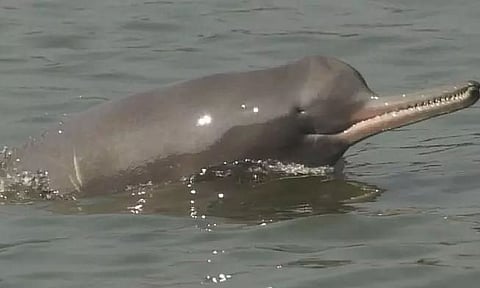
- Home
- Live Blog
- Breaking News
- Top Headlines
- Cities
- NE News
- Sentinel Media
- Sports
- Education
- Jobs

It is a matter of grave concern that River Kulsi, an important habitat of Assam's state aquatic animal- Xihu (Genges River Dolphin) has become dry at multiple locations due to rampant illegal mechanised sand mining from the river. Delay in the restoration of water flow regime in the river may lead to permanent destruction of the river ecology and loss of the habitat of the endangered Xihu in the Kulsi. A Wildlife Institute of India (WII) report revealed depth reduction of 70% in 2021 as compared to 2020. The WII found that of 35 segments (each segment of average 300-meter length) at every 100 meter of the river, nine segments had almost no water which led stranding of three river dolphins in Kukurmara stretch. The report states that Xihu requires two-meter depth of water for navigability, but water depth was less than or equal to one meter in these 35 segments in which WII conducted surveys. The southern tributary of the Brahmaputra originates in Meghalaya, and it flows for 76 km as Kulsi or Kalahi from Ukiam along the Assam-Meghalaya inter-state boundary till its confluence with the Brahmaputra at Nagarbera in Kamrup district. Construction of bridges and sluice gates has also led to fragmentation of the dolphin habitat and the WII has recommended bridges with suspension technology as a solution to the problem. The shifting of the water flow regime to Chaygaon River at its confluence with the Kulsi River in Kulsi village has been aggravated by rampant and unsustainable mechanised sand mining using suction pumps from Chaygaon River which meets again with the Kulsi in the downstream. Till some five six years ago only manual mining sand mining could be observed in the Kulsi. Manual mining process involves lifting sand with a bucket on boat and is considered sustainable as sand can be mined at the most two times a day on a boat as it labour-intensive. Sights of Xihu near the boats used in manual mining also opened avenues of eco-tourism with some boatmen taking nature lovers on a ride for rental fee along the stretch to have closer view of the rare species. To the contrary, in mechanised process huge amount of sand is sucked out of the riverbed. Besides, the mechanised process being illegal, no revenue is paid to the Forest Department so profit margin is manifold higher than manual mining which is allowed on sand mahals authorised by the Forest and Environment Department against payment of royalty. Seizure of excavators, dumpers, suctions pumps used in illegal mechanised sand mining multiple times could not bring a halt to illegal mining in Kulsi River which speaks volume about the gaps in surveillance by the department against such illegal activities. Drying of the river has adversely affected riparian communities living along the river as wetlands are not recharged leading to drastic decline in fishes and underground water tabling near the riverbank falling. The WII report also highlights that drying of the river has adversely affected livelihood of over 2000 fishermen families and farm families which are dependent on the river and wetlands on its catchments for fishing. Unplanned construction of boundary walls of industries in the river catchments affecting flow regime reflected how river ecology and the importance of conservation of Xihu were ignored while pushing such construction work. Reports of effluents coming out of one industry and flowing into Kulsi water warn of another environmental disaster posing the threat of polluting the entire river if not checked immediately. A year after the Assam government declared Xihu as the state aquatic animal, the Central Government declared the endangered species as the national aquatic animal in 2009 but drying of the river posing threat to its survival in the Kulsi River has failed to draw the attention of the Ministry of Environment, Forest and Climate Change. Kulsi sand has high demand in Guwahati market of building materials. Therefore, without regulating flow of sand supply from the Kulsi to the city, which is rapidly expanding horizontally and growing vertically, restoring water flow in the river will not be possible. The Kamrup district administration constituted a committee of experts after people living along the Kulsi organised a public protest and sought immediate solution to restore flow of water in the river. It is hoped that solutions offered by the expert committee will restore water flow and its ecosystem, but acceptance of solutions and their timely implementations by the State Government will be critical to conservation of the Kulsi River and habitat of the Xihu. Nature lovers, environment groups need to raise a voice against mechanised sand mining so that strong public vigil of local people against such illegal activities can be built up. An awareness drive to save the river eco-system, its river dolphin population has become an urgent necessity. Immediate priority must be on restoring the water flow in the Kulsi River.